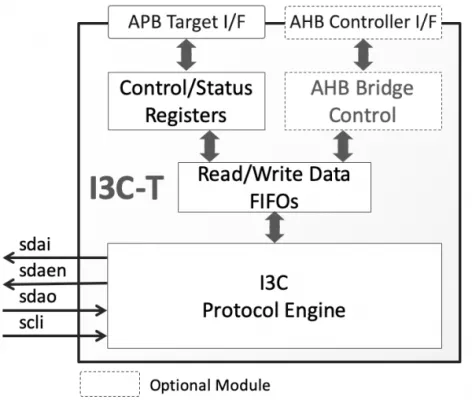The I3C-T core implements a versatile MIPI® Improved Inter Integrated Circuit (I3C) Target controller core suitable for any I3C bus topology & compliant with the latest MIPI I3C-BasicSM specification.
The highly featured target-only core communicates in Single Data Rate (SDR) mode, but can tolerate High Data Rate (HDR) traffic. It can coexist and communicate with legacy I2C devices, and it can optionally be configured to operate as such in an I3C or I2C bus. The I3C-T needs no firmware support to parse and execute the broadcast or direct Common Command Codes (CCCs) relevant to I3C Basic Targets. It can be assigned a Dynamic Address by the bus controller, or use its legacy I2C static address, it supports Hot Join and is capable of generating In-Band Interrupts when directed by the host to do so.
CAST is a MIPI Alliance member
Designed for easy integration, the I3C-T can operate in two different modes. Under normal mode, data from private I3C or legacy I2C write transfers are stored to a FIFO, and made available to the host via an APB Target interface. In a similar way, the host provides data to be used for private I3C or legacy I2C read transfers via the core’s APB target interface. Alternatively, the core can operate in I3C-to-AHB bridging mode, where it autonomously converts private I3C or legacy I2C transfers to accesses on its AHB controller port using a simple yet configurable over-I3C protocol. Under the I3C-to-AHB bridging mode, the core needs no software assistance and provides the I3C-controller access to the local AHB bus, enabling remote monitoring, configuration, debug, or data exchange. The selection between normal and bridging operation modes is under software control via the core’s control register.
The highly flexible core offers synthesis-time and run-time configuration options, which allow adapting its size and behavior to the application requirements. For example, the AHB-controller interface and the clock domains synchronizers can be removed at synthesis time to reduce the core’s silicon footprint. During run-time, the I3C private data and I2C traffic can be bridged to the core's AHB controller interface or transferred to and from the host via the core's APB Targer interface. Also, parameters defining the CCCs processing (e.g. own-address, provisional ID, acknowledge for different type CCCs), the over-I3C protocol (i.e. number address bytes, max number of data bytes), and the AHB-controller port behavior (e.g AHB burst type & address wrapping) are all run-time configurable via the core’s registers.
The I3C-T core adheres to the industry’s best coding and verification practices to ensure trouble-free implementation in ASIC or FPGA technologies. Technology mapping, constraining, and scan insertion are straight-forward, as the core contains no multi-cycle or false paths, and uses only rising-edge-triggered D-type flip-flops, no tri-states, an asynchronous reset line per clock domain, and clean clock domain crossing modules. Its reliability and low risk have been proven through rigorous verification and FPGA validation.
The core is available in synthesizable Verilog format or as a targeted FPGA netlist, and its deliverables include everything required for successful implementation, including a system-Verilog test-bench, synthesis, and simulation scripts, and comprehensive documentation.
MIPI I3C Basic Target
Overview
Key Features
-
I3C Features
- I3C-Basic, up to 12.5 Mbit/s SDR-Capable and HDR-Tolerant Target
- Autonomous processing of all Broadcast and Direct Common Command Codes (CCCs) relevant to an I3C-Basic target.
- Hot-Join Mechanism
- In-Band Interrupts I3C Bus and Device Characteristic Registers (BCR & DCR),
- Dynamic Addressing Assignment
- Optional operation as a legacy I2C device, and interoperable with legacy I2C devices
- Supports I2C static addressing, I2C messaging, and a 50ns spike filter
-
Easy to Use & Integrate
- Run-time selectable operation modes:
- Autonomous I3C-to-AHB bridge
- Firmware-assisted, I3C controller exchanging data with the host via APB-accessible registers, or implementing a custom over-I3C protocol
- Standardized AMBA interfaces
- APB-Subordinate for register access
- AHB-Manager (when I3C-to-AHB bridging mode is enabled)
- Independent clocks for APB. AHB and I2C with clean clock domain crossing
- Fully synchronous, scan-ready, LINT-clean design
- Run-time selectable operation modes:
-
Configuration Options
- Synthesis Time: FIFO sizes, AHB-manager Interface and Clock Synchronizers instantiation
- Run Time: Data traffic source & target selection (AHB-manager I/F or APB Accessible Registers & FIFOs), and FIFO Interrupt threshold
Block Diagram

Applications
- The I3C-S core can add economical and low-power I3C data transfer capabilities to sensors, actuators, power regulators, analog front-ends, microcontroller peripheral devices, microcontrollers, or even FPGA devices and designs.
Deliverables
- Verilog RTL or FPGA netlist
- Testbench
- Sample simulation and synthesis script
- Extensive documentation
- Sample software driver
Technical Specifications
Maturity
Silicon Proven
Availability
Now
Related IPs
- MIPI I3C v1.1.1 Basic Controller and Target
- MIPI I3C v1.1.1 Basic Target lite
- MIPI I3C Controller
- I3C Controller IP – Master / Slave, Parameterized FIFO, APB Bus. I3C Basic Specification Design
- MIPI I3C Basic v1.1.1 specifications with Host Controller Interface v1.1 specification
- Power Management IC - I3C Basic Interface IP